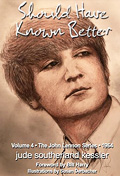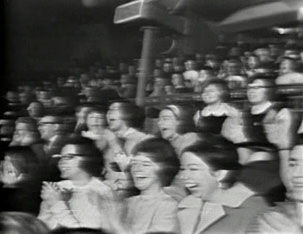


|
|
Glass Onion
Every Little Thing
Dear Sir or Madam...

The John Lennon Series by Jude Southerland Kessler
Hello, Goodbye Comment? Question?
|
|
The Story Behind The Beatles on Ed Sullivan by Bruce Spizer, Beatles author and historian On Sunday, Feb. 9, 1964, over 73 million Americans gathered around television sets to see what all the excitement was about. For several weeks American radio stations had been saturating the airwaves with Beatles music. The power of radio had led to sales of millions of Beatles singles and albums. For weeks, the country had been warned "The Beatles Are Coming!" The American press picked up on the story, with several magazines and newspapers running feature stories on the group. Two days earlier, CBS and ABC showed film of The Beatles' arrival in America at New York's Kennedy Airport on their evening news shows. But the big event was The Beatles' first live appearance on American television, which took place on the country's most popular variety program, "The Ed Sullivan Show". The excitement began shortly after 8 p.m. EST when Sullivan gave his famous introduction: "Now yesterday and today our theater's been jammed with newspapermen and hundreds of photographers from all over the nation, and these veterans agreed with me that the city never has the excitement stirred by these youngsters from Liverpool, who call themselves The Beatles. Now tonight, you're gonna twice be entertained by them. Right now, and again in the second half of our show. Ladies and gentlemen, The Beatles. Let's bring them on."
 Sullivan's last words were drowned out by the screaming young girls in attendance at CBS Studio 50. After Paul McCartney's count-in, the group opened with one of the more popular tracks from their Capitol album, "All My Loving". It was an energetic performance that showed The Beatles had total command of the situation. The girls yelled and bounced in their seats for the entire song. Upon its completion, the crowd screamed even louder and wildly applauded as the group bow in unison. Paul took the spotlight again on "Till There Was You". A lovely ballad from "The Music Man" that even the adults in the audience could appreciate. Although the girls were quiet at first, the screaming resumed early on, with one youngster shouting "Ringo" as George Harrison took a solo on his Gretsch Country Gentleman guitar. During the song, the camera focused on each member of the group, with his first name superimposed on the screen. When it came time for John Lennon, "SORRY GIRLS, HE'S MARRIED" appeared below his name. The relative calm of the ballad was quickly shattered by a rocking version of "She Loves You" that provided a bold demonstration of the big beat sound. The loudest screams occurred each time John, Paul, and George went "Woooo" and shook their heads. When it was over, The Beatles took their customary bow.
 Thirty-five minutes later, Sullivan introduced the group's second segment with a simple, "Ladies and gentlemen, once again." The Beatles then played boot-tapping versions of both sides of their Capitol single, "I Saw Her Standing There" and the No. 1 hit "I Want to Hold Your Hand." During these songs, as well as the earlier performances, the cameramen did a superb job of capturing The Beatles and the excitement of the event despite being unable to hear the director's instructions through their headphones over the screaming girls. The last song effectively mixed long shots, close-ups, crowd shots and a move in and out on drummer Ringo Starr by a mobile crane camera. After taking their bows, John, Paul and George removed their instruments and Ringo jumped down from his drum riser. The group then headed over to Sullivan to shake hands and wave to the crowd. For many, The Beatles on "The Ed Sullivan Show" was a defining moment comparable to "Where were you when Kennedy was shot?" or man's first steps on the moon. The powerful sounds and images of those performances are forever embedded in our minds. For 40 years, the story of The Beatles on Sullivan has been told in countless books, articles and documentaries, but often with myths and misinformation. The official version of how Ed Sullivan learned about The Beatles begins on Oct. 31, 1963. On that day, Sullivan and his wife were at London Airport. It was an unusually busy day at the airport with the prime minister due to fly out and contestants for the Miss World contest (being held that year in London) arriving. Although the city was experiencing a heavy rainstorm that day more than 1,500 youngsters lined the rooftop gardens of the Queen's Building and others congregated on the ground. Sullivan asked what all the commotion was about and was informed that it was for The Beatles, who were returning from a tour of Sweden. He replied, "Who the hell are The Beatles?" Sullivan was told that the Beatles were a well-known pop group. Although Sullivan would later claim that the incident caused him to immediately inquire into booking The Beatles on his show, the true story is a bit more involved. Jack Babb, who was the talent coordinator for the Sullivan show, spent his summers in Europe checking out potential acts for the program. He was assisted by Peter Prichard, a London theatrical agent who was also employed by Sullivan as his European talent coordinator. Prichard became good friends with Sullivan and Babb. He also knew Beatles manager Brian Epstein, who sometimes called him for advice. During the summer of 1963, Prichard took Babb to see The Beatles on at least one occasion. Although The Beatles were developing a following on the British concert circuit and had two No. 1 singles and a chart-topping album, the group had yet to become part of the national consciousness. Because no British pop act had ever achieved prolonged success in America, neither Prichard nor Babb gave consideration to booking The Beatles on the Sullivan show. By September 1963, The Beatles were gaining coverage in the British press and were receiving tremendous radio and television exposure. But their big break through was a widely-watched and well-publicized television appearance on "Val Parnell's Sunday Night at the London Palladium", which was televised throughout the U.K. during prime time Sunday evening and was the British equivalent of "The Ed Sullivan Show". The Beatles headlined the Oct. 13, 1963, Palladium show, which was seen by more than 15 million people. The bedlam caused by the group both inside and outside the theater caught the attention of British news editors, who elevated The Beatles from a successful entertainment act to a national news phenomenon. The Daily Mirror described the hysteria as "Beatlemania!" The term stuck. The Beatles' triumphant Palladium appearance was quickly followed by the Oct. 31 airport reception witnessed by Sullivan and their playing before British high society at the Royal Command Performance, also known as the Royal Variety Show. Their presence on the Nov. 4, 1963, show drew more attention than the arrival of Royal Family. The Beatles, who were seventh on the bill of 19 acts, impressed the upscale crowd with "She Loves You", "Till There Was You", "From Me To You" and "Twist and Show". Prior to ripping into a rousing rendition of their closing rocker, Lennon said, "For our last number I'd like to ask your help. Would the people in the cheaper seats clap your hands? And the rest of you, if you'll just rattle your jewelry." While Epstein viewed John's remarks as being a bit risque, he was relieved that the crowd seemed charmed by the Beatle's cheeky humor. Before the show, John had joked to Brian that he was going to ask the Royals to rattle their "fookin' jewelry." The next day Epstein headed to New York with Billy J. Kramer, a 20-year-old singer who was one of the other acts he managed. The primary purpose of the visit was to promote Kramer, whom Epstein hoped would develop into a successful cabaret crooner capable of headlining shows in New York and Las Vegas. The other purpose of his visit was to explore why The Beatles hadn't "happened" in America and, more important, perhaps do something about it by "spreading the gospel of The Beatles in the U.S.A." Prior to leaving for New York, Epstein was contacted by Prichard, who said he should try to get The Beatles on "The Ed Sullivan Show" and offered to negotiate a deal. When Brian said that he would rather handle the negotiations himself, Prichard told Brian to call him when he got to New York so that he could set up a meeting with Sullivan. As Epstein's plane was heading to New York, Prichard began workout his pitch to Sullivan for The Beatles. He later called Sullivan and gave him a report on the Royal Variety Show. Prichard mentioned the tremendous response The Beatles received and recommended that Sullivan book The Beatles for his show. Sullivan, remembering the large crowd at London Airport, was interested, but needed an angle to promote the group, which at the time was still unknown in America. Prichard informed Sullivan that The Beatles were the first "long haired boys" to be invited to appear before the Queen of England. That convinced Sullivan to consider the group for his show. Epstein's 1963 appointment book indicates he met with Sullivan at his suite at the Delmonico Hotel on Monday, Nov. 11. This was followed by a 5 p.m. dinner meeting the next day at the Delmonico Hotel's restaurant. The initial meeting was apparently attended only by Epstein and Sullivan. They tentatively agreed that The Beatles would appear on Sullivan's Feb. 9, 1964, show live from New York, and then the following week on a special remote show broadcast live from th4e Deauville Hotel in Miami Beach. Bob Precht, Sullivan's son-in-law and producer, was asked to attend the second meeting during which the deal was finalized. Upon his arrival at the Delmonico, Precht was introduced to Epstein and told by Sullivan that the manager had a great group of youngsters who were going to be "really big". Although Sullivan paid up to $10,000 for a single performance, he offered Brian $3,500 for each show. He agreed to pay the group's transportation and lodging. Realizing the importance of having his boys on the Sullivan show, Brian agreed to the deal provided The Beatles received top billing. Although Brian claimed Sullivan gave in to this demand, it is unlikely that Sullivan did more than agree to consider top billing for the group. By the time the first show aired three months later, Sullivan eagerly promoted The Beatles as the headline act. However, Mitzi Gaynor received top billing for the Miami Beach Show. Precht suggest that in addition to the two live programs, The Beatles should tape a performance for alter broadcast. The parties agreed on a payment of $3,000 for the taped segment, thus bringing the total for the three shows to $10,000. As was often the case with Epstein's negotiations, the deal was then sealed with a handshake. After leaving the meeting, Precht began having second thoughts about featuring the unknown British band on the show and called Sullivan at his suite to voice his concerns. Sullivan assured him that he felt it was worth the investment. And that ended the matter. The decision had been made. Sullivan later told The New York Times, "I made up my mind that this was the same sort of mass hit hysteria that had characterized the Elvis Presley days."
| ||||||||||||
|
|
Search this site
WARNING! IMPORTANT ALLERGY INFORMATION!
THIS WEBSITE MAY CONTAIN JELLY BABIES.
Original Content Copyright © 1995-2024 Adam Forrest
